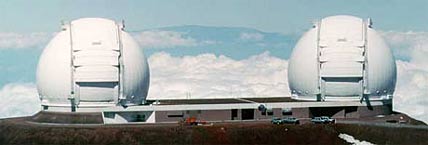
The domes of the giant Keck I and Keck II telescopes are 85 meters (300 feet) apart. NASA hopes to build six 1.8-meter 'outrigger' telescope around the two main domes as part of the Keck interferometric array.
Courtesy Keck Observatory / NASA / JPL.
In their quest to create the world's greatest visible-light interferometer, Keck Observatory planners recently suffered a significant setback. A federal court ruled on July 15th that NASA must perform a more comprehensive environmental assessment of the Mauna Kea mountaintop site before construction can proceed.
Back in April 2002, the Office of Hawaiian Affairs (OHA) filed suit against NASA and the University of Hawaii to prevent Keck Observatory from building six 1.8-meter outrigger telescopes alongside the observatory's two 10-meter domes (S&T: August 2002, page 28). These "sideKecks" would complete the telescope's interferometric array and allow astronomers to produce visual images of the cosmos from Earth with unprecedented resolution.
The OHA suit sought to stop the telescopes' construction by placing a preliminary injunction against NASA until the agency produced a full environmental impact statement (EIS). NASA had produced a less rigorous environmental assessment (EA), resting on the fact that the site was evaluated comprehensively in 1991.
US District Judge Susan Oki Mollway ruled that the OHA suit had merit in that NASA's EA lacked the rigor and comprehensive nature to adequately assess the cumulative environmental impact that further construction on the mountain might have on the ecosystem and possible historical remains. Mauna Kea is home to a rare species of insect and is revered as a sacred place in the Hawaiian culture. It is an ancient burial site for high priests and chieftains.
In the judgment filed by the court, Mollway writes that NASA's EA "fails as a whole to recognize and consider the past actions on the summit of Mauna Kea." Furthermore, Mollway writes, "because there is no previous EIS or EA that encompasses the site of the outrigger telescopes project, NASA's obligation to consider the cumulative impacts of development at the Keck observatory is correspondingly greater."
However, the court refused to rule as to whether NASA must perform a full EIS before beginning construction. Doing so would likely delay the project for nearly a year and could cost millions. Instead, according to Mollway, "The court . . . does not find compelling OHA's argument that NASA's regulations require NASA to prepare an EIS based on the potential impact of the outrigger telescopes project." An EA that meets the requirements laid out in the ruling could be enough, but that will be up to a future court to decide.
In the meanwhile, despite having an inadequate EA, NASA can still proceed with obtaining the permits needed to begin construction. But first, the agency plans to regroup and evaluate the judgment in detail. NASA officials say that all options are being assessed and that no timetable has been set for a decision about the next course of action.
In response to the court ruling, in a prepared statement, Robert McLaren, associate director for the University of Hawaii's Institute for Astronomy, said, "The University of Hawaii remains convinced that spiritual, cultural, and environmental values can be integrated with scientific endeavors for the benefit of all."
 0
0









Comments
You must be logged in to post a comment.